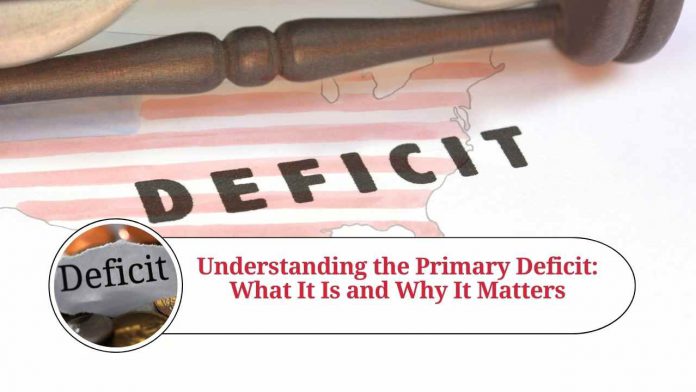Understanding the Primary Deficit: Definition, Causes, and Implications
Governments around the world are expected to manage their finances effectively in order to achieve macroeconomic stability and sustainable economic growth. One key metric that is used to assess a government’s fiscal performance is the budget deficit, which refers to the amount by which government spending exceeds its revenue in a given year. However, it is also important to distinguish between different types of deficits, including the primary deficit. In this blog post, we will explain what the primary deficit is, its causes, and its implications for the economy.
What is the Primary Deficit?
The primary deficit is a measure of a government’s budget balance that excludes interest payments on outstanding debt. In other words, it represents the gap between government revenue and spending, excluding the cost of servicing existing debt. The primary deficit is a useful indicator of a government’s ability to manage its finances sustainably over the long term, as it reflects the extent to which a government is reliant on borrowing to fund its spending.
Causes of the Primary Deficit
There are a number of factors that can contribute to the primary deficit. One key driver is excessive spending by the government, which can occur due to a range of factors such as pressure to provide public services or a lack of fiscal discipline. Another factor is a shortfall in government revenue, which can result from factors such as weak economic growth, lower-than-expected tax receipts, or changes in the tax system that reduce revenue. Other factors that can contribute to the primary deficit include demographic changes, such as an ageing population, and external shocks such as natural disasters or changes in global commodity prices.
Implications of the Primary Deficit
The primary deficit can have important implications for the economy, both in the short term and the long term. In the short term, a high primary deficit can lead to inflationary pressures, as the government may need to borrow more to finance its spending, increasing demand for credit and pushing up interest rates. This can lead to higher inflation and reduced economic growth, as businesses and consumers face higher borrowing costs. In the long term, a high primary deficit can lead to a build-up of government debt, as the government may need to borrow more to finance its spending over time. This can lead to higher interest payments, reducing the government’s ability to fund public services and invest in the economy.
The primary deficit is closely related to the concept of fiscal sustainability, which refers to a government’s ability to finance its spending over the long term without relying on unsustainable levels of borrowing. A high primary deficit can signal a lack of fiscal sustainability, as it suggests that the government is relying on borrowing to fund its spending. This can lead to concerns about the government’s ability to service its debt in the future, which can have implications for its credit rating and ability to borrow in the international markets.
The primary deficit is also an important metric for assessing a government’s fiscal policy stance. A government that runs a high primary deficit is likely to be pursuing expansionary fiscal policy, which involves increasing government spending and/or reducing taxes in order to stimulate economic growth. Expansionary fiscal policy can be an effective tool for addressing short-term economic challenges, such as recessions or high unemployment. However, if it is pursued for an extended period of time, it can lead to a build-up of government debt and inflationary pressures.
Conversely, a government that runs a low or positive primary deficit is likely to be pursuing a more conservative fiscal policy stance. This involves reducing government spending and/or increasing taxes in order to reduce the deficit and/or pay down government debt. While this approach can help to improve the government’s fiscal position over time, it can also have negative short-term effects on economic growth and employment.
In some cases, governments may choose to run a primary surplus, which means that government revenue exceeds spending (excluding interest payments on outstanding debt). This approach can help to reduce government debt over time, but it can also have negative short-term effects on the economy, as it involves reducing government spending and/or increasing taxes.
Conclusion
In conclusion, the primary deficit is an important metric for assessing a government’s fiscal performance and policy stance. It reflects the extent to which a government is reliant on borrowing to fund its spending, and can have important implications for the economy, including inflationary pressures and a build-up of government debt. Governments must therefore manage their finances effectively to ensure a sustainable fiscal position over the long term, while also balancing the short-term needs of the economy.
Read more useful content:
Frequently Asked Questions (FAQs)
What is the primary deficit?
The primary deficit is a measure of a government’s budget balance that excludes interest payments on outstanding debt. It represents the gap between government revenue and spending, excluding the cost of servicing existing debt.
How is the primary deficit different from the budget deficit?
The budget deficit is the amount by which government spending exceeds its revenue in a given year, including interest payments on outstanding debt. The primary deficit, on the other hand, excludes interest payments.
Why is the primary deficit important?
The primary deficit is important because it reflects the extent to which a government is reliant on borrowing to fund its spending. A high primary deficit can have implications for inflation, interest rates, and the government’s ability to service its debt.
What are some factors that can contribute to the primary deficit?
Factors that can contribute to the primary deficit include excessive government spending, a shortfall in government revenue, demographic changes, and external shocks such as natural disasters or changes in global commodity prices.
How can a government reduce the primary deficit?
A government can reduce the primary deficit by increasing revenue through tax increases or reducing spending on public services.
What are the implications of a high primary deficit for inflation?
A high primary deficit can lead to inflationary pressures, as the government may need to borrow more to finance its spending, increasing demand for credit and pushing up interest rates.
What are the implications of a high primary deficit for government debt?
A high primary deficit can lead to a build-up of government debt, as the government may need to borrow more to finance its spending over time. This can lead to higher interest payments, reducing the government’s ability to fund public services and invest in the economy.
What is fiscal sustainability?
Fiscal sustainability refers to a government’s ability to finance its spending over the long term without relying on unsustainable levels of borrowing. A high primary deficit can signal a lack of fiscal sustainability.
What is expansionary fiscal policy?
Expansionary fiscal policy involves increasing government spending and/or reducing taxes in order to stimulate economic growth. It can be an effective tool for addressing short-term economic challenges, such as recessions or high unemployment.
What is conservative fiscal policy?
Conservative fiscal policy involves reducing government spending and/or increasing taxes in order to reduce the deficit and/or pay down government debt. While this approach can help to improve the government’s fiscal position over time, it can also have negative short-term effects on economic growth and employment.




















